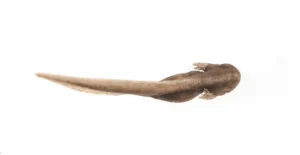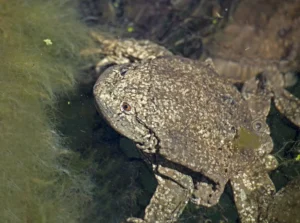Most frogs lay eggs, which then hatch into tadpoles that develop and metamorph into adult frogs over time. In each of these life stages, frogs will use many different organs for gas exchange.
Frogs have gills as tadpoles, which are lost when the tadpoles reach the froglet stage of their development. As adults, frogs do not have gills, and breathe using their lungs as well as through their skin and thin membranes in their mouth and throat.
When submerged in water, adult frogs hold their breath and breathe entirely through their skin.
Dissolved oxygen in the water that comes in contact with their skin is diffused into their bloodstream, and carbon dioxide is released from the bloodstream into the water. This process of “skin breathing” is known as cutaneous respiration
Frog Tadpoles Have Gills
Tadpoles are very different from adult frogs; this is because they’re adapted for a fully aquatic life, while adult frogs are adapted for a semi-aquatic, or mostly terrestrial life (depending on the species).
External Gills
When first hatched, tadpoles have external gills, often in pairs, on either side of their heads. They use these gills to breathe in the water, just like fish.


The gills have thin membranes and a very large network of small blood vessels called capillaries. As water runs over the gills, the membranes absorb dissolved oxygen from the water and move it into the bloodstream.
The tadpole’s heart then pumps the oxygenated blood to distribute the oxygen throughout the body, just like in humans.
At the same time, waste carbon dioxide in the blood passes through the gills, and into the water.
Internal Gills
When tadpoles are in the middle stages of development (time frame can vary depending on the species), opercular folds grow backward from the hyoid arch of each side covering the external gills and gill slits.

In this way, a gill cover known as an “operculum” is formed enclosing the external gills and gill slits – turning the external gills into internal gills. These internal gills are vented by ventrolateral openings, known as spiracles.
Depending on the species, there can be:
- Two spiracles on both sides of the body,
- A single spiracle on the underside near the vent, or
- A single spiracle on the left side of the body
Spiracles are tubular structures leading out of the opercular chamber. Tadpoles eject water through the nostrils and through the spiracles.
During metamorphosis, the gills are broken down, the lungs develop rapidly into the main organ of respiration.
Tadpoles Turn Into Frogs
After a few months to a few years (depending on the species) the tadpoles will go through a process known as metamorphosis, in which they will transform into juvenile frogs.

This hormone triggers the tadpoles to:
- Absorb the tail into the body
- Grow strong legs for moving on land
- Remodel other organs to form an adult frog
During metamorphosis, tadpoles will also gradually lose their gills. While the gills are being broken down, the lungs develop rapidly into the main organ of respiration.
Once metamorphosis fully is complete, the tadpoles will be young frogs and will leave the water to live on land. These young frogs will grow and mature into adults over time.
Adult Frogs Do Not Have Gills
Once the metamorphosis from tadpole to frog is complete – frogs do not have any gills. They breathe using their lungs as well as through their skin and thin membranes in their mouth and throat (cutaneous respiration).
That said, it’s important to note that amphibian lungs are quite primitive when compared to our own.
Frogs do not have diaphragms to push air into the lungs as we do. Instead, they rely on a process known as “buccal pumping.”
Buccal Pumping is basically a process of moving air in and out of the lungs through the use of the mouth and throat muscles.

To breathe in, the frog will lower the floor of its mouth, which causes the throat to expand. Air then rushes into the throat, through the mouth, and through the open nostrils.
The frog will then close its nostrils, and raise the floor of its mouth, which causes the throat to contract, and pushes the air into the lungs.
Once the air is in the lungs, oxygen from the air is then absorbed into the frogs’ bloodstream. At the same time, carbon dioxide from the bloodstream is diffused into the air.
To breathe out, the frog will lower the floor of its mouth, which causes the throat to expand and draws the air from the lungs, and into the mouth. It will then open its nostrils, and raise the floor of its mouth, to push the air out of the nostrils.
How Adult Frogs Breathe Through Their Skin
Lungs alone usually can not give a frog all the oxygen it needs. For this reason, frogs can also breathe through their skin and thin membranes in their mouth and throat to get extra oxygen, in a process known as cutaneous respiration.
The skin is made up of thin membranous tissue that is highly permeable to water and contains a large network of capillaries and other blood vessels close to the surface.
The thin membranous skin allows oxygen from the air to be absorbed into the bloodstream via diffusion. At the same time, carbon dioxide from the bloodstream passes through the skin and membranes and is diffused into the air.
To efficiently breathe, frogs have to keep their skin constantly moist by secreting a mucous coating. They can only absorb oxygen through their skin if the skin stays moist. If it dries up, they can suffocate and die.
In some frog species, cutaneous respiration is so efficient that it is their main way of breathing.
Stage of Development |
Organs for Gas Exchange |
| Early Tadpole | External gills, Skin, (and Lungs in some species) |
| Mid Tadpole | Internal gills, Skin, (and Lungs in some species) |
| Late Tadpole | Internal gills, Skin (and Lungs in some species) |
| Froglet | Lungs, Skin, and membranes in the mouth and throat |
| Adult frog | Lungs, Skin, and membranes in the mouth and throat |
How Do Adult Frogs Breathe Underwater?
When submerged, frogs can not use their lungs to breathe air. For this reason, they hold their breath and breathe underwater entirely through their skin (cutaneous respiration).
Dissolved oxygen in the water that comes in contact with their skin is diffused into their bloodstream, and carbon dioxide is released from the bloodstream into the water.
However, this method of breathing usually does not give frogs all the oxygen they need, so they can only be submerged for a limited time before they have to resurface to breathe air with their lungs.
Exactly how long a particular frog can stay underwater depends on; how much oxygen it can absorb from the water through its skin, vs how much oxygen its body needs for metabolism.
This is usually affected by: the oxygen content of the water, the temperature, species, and how active the frog is.
1. Oxygen Content of the Water
Frogs can stay submerged in water with a high oxygen content for much longer than they can in water with low oxygen content.
Many things influence how much oxygen there is in a particular body of water.
For instance, fast-flowing or ‘stirred up’ water generally contains more oxygen than still water. This is because oxygen from the air is dissolved in water at its surface, mostly through turbulence (for example waves, riffles, water tumbling over rocks, etc).
In still water, oxygen only dissolves on the water’s surface, so the deeper you go into the water the less oxygen there is.
Additionally, aquatic plants and algae also affect the oxygen content of water. During the daylight hours, they produce oxygen through photosynthesis and release it into the water.
At night, they will use up dissolved oxygen in the water via aerobic respiration and release carbon dioxide into the water.
Also, water with lots of decaying plants will have a lower oxygen content. This is because the bacteria responsible for the process of decomposition use oxygen and release carbon dioxide into the water, reducing the oxygen content of the water.
2. The Water Temperature
Frogs are ectothermic (cold-blooded) animals, so the environmental temperatures will affect their rate of metabolism. At higher temperatures, they will have a higher metabolic rate, meaning they have a greater oxygen demand.
At lower temperatures, the opposite is true. Frogs will have a lower metabolic rate meaning they have a lower oxygen demand.
Also, Cold water can hold more dissolved oxygen than warm water. This means the oxygen content of the water will be higher when the temperatures are low.
All this combined means frogs can stay submerged at lower temperatures for much longer than they can at warmer temperatures.
3. The Frog Species
Tadpoles have gills that provide a very large surface area to absorb lots of oxygen from the water. However, as adults, frogs do not have gills, so how much oxygen they can absorb from the water depends partly on their skin surface area to body volume ratio.
Some frog species have a very large skin surface area and are better at absorbing oxygen from the water than others.
For example, the Titicaca water frog (Telmatobius culeus) is an aquatic frog species with wrinkled skin. This frog’s excessive amount of skin makes it look rather as if it were wearing an oversized wet suit. But it performs a very important function – it provides a bigger surface area to use for cutaneous respiration.

Their very large skin functions in a manner that is comparable to gills. Sometimes, they bob up–and–down to allow more water to pass by their large skin folds.
Titicaca water frogs do not need to surface regularly to breathe air. They can stay submerged for several days in normoxic water, breathing entirely through their skin.
4. How Active the Frog Is
Activity affects how much oxygen the body needs. Think about it, when we are running or jogging, we breathe heavier and in much quicker breaths than when we are at laying on the couch.
For frogs, this is also true. They will have a higher oxygen demand when they are very active in the water (escaping a predator for example), and a lower oxygen demand when they are inactive.
For this reason, frogs will be able to stay underwater when at rest for much longer than when they are active.
During the winter, some frog species such as leopard frogs will hibernate underwater and can stay submerged all winter long. Their lower metabolic rate during hibernation/brumation means they can meet all their oxygen needs via cutaneous respiration alone.
Commonly Asked Questions
When do tadpoles lose their gills?
In general, tadpoles lose their gills as they transition into the froglet stage of their development. This is about 12 – 14 weeks after hatching in many frog species. However, different frog species develop at different rates, so there is one size fits all answer here.
Some frogs, such as New Mexico spadefoot toads (Spea multiplicata), can metamorphosize from tadpole to frog in only two to three weeks, while the tadpoles of the Coastal-tailed frog (Ascaphus truei) can take up to 4 years before they transform into frogs.
Sources:
Warren W. Burggren, Nigel H. West, Changing respiratory importance of gills, lungs and skin during metamorphosis in the bullfrog rana catesbeiana, Respiration Physiology, Volume 47, Issue 2, 1982, Pages 151-164, ISSN 0034-5687, https://doi.org/10.1016/0034-5687(82)90108-6.
Martin E. Feder, Richard J. Wassersug; Aerial Versus Aquatic Oxygen Consumption in Larvae of the Clawed Frog, Xenopus Laevis. J Exp Biol 1 January 1984; 108 (1): 231–245. doi: https://doi.org/10.1242/jeb.108.1.231
Uchiyama M, Yoshizawa H. Salinity tolerance and structure of external and internal gills in tadpoles of the crab-eating frog, Rana cancrivora. Cell Tissue Res. 1992 Jan;267(1):35-44. doi: 10.1007/BF00318689. PMID: 1735117.


